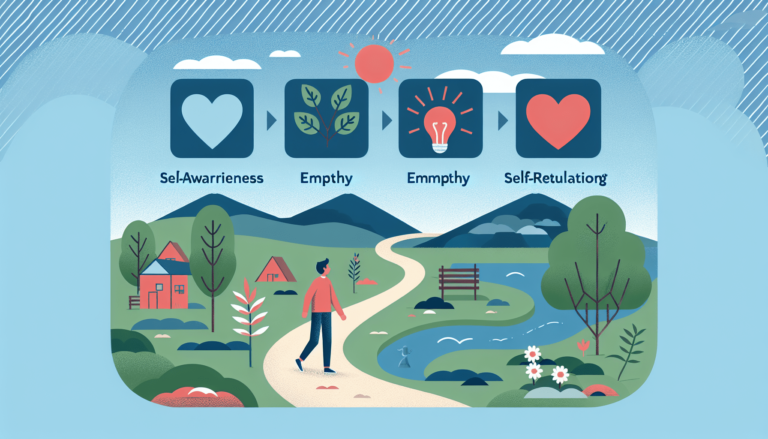Mastering Self-Motivation: Techniques That Work
You’ve probably experienced moments when you lacked the motivation to start a new project or push through a challenging task. But what if you had the power to ignite your own motivation, whenever and wherever you needed it? In this article, we’ll explore a range of practical techniques that can help you master self-motivation. From setting clear goals and creating a positive mindset, to harnessing the power of visualization and celebrating small wins, these strategies will empower you to take control of your motivation and achieve your goals. Get ready to unlock your inner drive and discover the techniques that work for you!

Understanding Self-Motivation
Defining self-motivation
Self-motivation refers to the ability to generate the drive and determination needed to pursue and achieve personal goals. It is an internal force that propels individuals towards success, even in the face of obstacles and challenges. Unlike external factors that may provide temporary motivation, such as rewards or praise from others, self-motivation stems from within oneself and is fueled by personal desires, values, and aspirations. It is a key factor in achieving long-term success and fulfillment in various areas of life.
The importance of self-motivation
Self-motivation is crucial for several reasons. Firstly, it serves as the fuel that keeps individuals consistently engaged and proactive towards their goals. When you are self-motivated, you become the driving force in your own life, taking necessary actions and maintaining a sense of purpose. Secondly, self-motivation empowers you to overcome obstacles and setbacks. It provides you with the resilience and determination necessary to bounce back from failures and keep moving forward. Finally, self-motivation is essential for personal growth and development. It pushes you to continuously strive for improvement and unleash your full potential, leading to a more fulfilling and successful life overall.
The benefits of mastering self-motivation
Mastering self-motivation offers numerous benefits. Firstly, it boosts productivity as you become more focused and driven to accomplish tasks and achieve goals. With self-motivation, you are less likely to procrastinate or get distracted, resulting in increased efficiency and effectiveness in your work or personal endeavors. Additionally, self-motivation enhances your mental and emotional well-being. It cultivates a positive mindset, increases self-confidence, and reduces stress and anxiety. When you are motivated, you feel a sense of purpose and accomplishment, contributing to overall happiness and life satisfaction. Lastly, self-motivation promotes personal growth and success. By consistently challenging yourself and pursuing meaningful goals, you expand your skills, knowledge, and experiences, opening doors to new opportunities and achievements.
Identifying Personal Drivers
Understanding intrinsic and extrinsic motivators
To unlock self-motivation, it is essential to understand the two main types of motivators: intrinsic and extrinsic. Intrinsic motivators come from within and are driven by personal desires and values. They include the satisfaction gained from personal growth, the love for a particular activity, or the fulfillment of achieving a goal. Extrinsic motivators, on the other hand, are external rewards or pressures, such as money, recognition, or praise from others. While both types can provide temporary motivation, mastering self-motivation requires focusing on intrinsic drivers that align with your authentic self and personal aspirations. By tapping into what truly matters to you, you can cultivate a lasting and deeply rooted motivation that drives you towards success.
Reflecting on personal values and goals
To identify your personal drivers, take time for self-reflection. Consider what values and principles are most important to you in life. What are your passions, dreams, and aspirations? Reflect on what truly motivates and inspires you, whether it be personal growth, making a positive impact, or achieving financial security. Additionally, evaluate your short-term and long-term goals. What do you want to accomplish in different areas of your life, such as career, relationships, health, and personal development? By aligning your goals with your intrinsic motivators, you can create a strong foundation for self-motivation and ensure that your pursuits are meaningful and fulfilling.
Examining past successes and failures
Looking back at your past successes and failures can provide valuable insights into your personal drivers. Identify moments when you felt most motivated and achieved significant milestones. What factors contributed to your motivation during those times? On the other hand, reflect on instances when you lacked motivation or faced difficulties in achieving your goals. What were the underlying reasons for your lack of motivation? By examining these experiences, you can gain a deeper understanding of what drives and hinders your self-motivation. Use this knowledge to adapt your approach and create strategies to enhance your motivation moving forward.
Setting Clear and Meaningful Goals
The power of setting goals
Goal setting is a powerful tool for self-motivation. By clearly defining what you want to achieve, you provide yourself with a target to work towards. This focus helps to direct your energy and efforts, making them more intentional and purposeful. Setting goals also provides a sense of direction and clarity, guiding your decision-making and prioritization. Moreover, the act of setting goals can boost motivation by creating a sense of challenge and excitement. It allows you to envision the future you desire and motivates you to take action to make it a reality.
SMART goal-setting technique
To maximize the effectiveness of goal setting, it is valuable to utilize the SMART goal-setting technique. SMART stands for Specific, Measurable, Achievable, Relevant, and Time-bound. Specific goals are clear and well-defined, avoiding ambiguity and confusion. Measurable goals include clear criteria to assess progress and determine when a goal has been accomplished. Achievable goals are realistic and attainable, taking into account your resources and capabilities. Relevant goals align with your overall values and aspirations, ensuring they are meaningful and impactful. Lastly, time-bound goals have a specific deadline, providing a sense of urgency and preventing procrastination.
Breaking down long-term goals into smaller milestones
Long-term goals can sometimes feel overwhelming and daunting, leading to a lack of motivation. To counteract this, break down your long-term goals into smaller, manageable milestones. These milestones act as checkpoints along your journey, allowing you to track progress and maintain motivation. By focusing on shorter-term objectives, you create a series of achievable tasks rather than a single overwhelming goal. Celebrating the completion of each milestone provides a sense of accomplishment and fuels ongoing motivation. This approach also provides an opportunity to adjust and refine your strategy as you progress, ensuring you stay on the right path towards your ultimate goal.
Fostering a Positive Mindset
Understanding the role of mindset in self-motivation
Mindset plays a crucial role in self-motivation. It refers to your attitudes, beliefs, and perceptions about yourself and the world around you. A positive mindset is an essential ingredient for cultivating and maintaining self-motivation. It involves cultivating a belief in your abilities, focusing on growth and learning, and embracing challenges as opportunities for personal development. With a positive mindset, you are more likely to approach tasks and goals with enthusiasm and determination, even in the face of setbacks or obstacles.
Practicing self-affirmation and positive self-talk
Self-affirmation and positive self-talk are powerful techniques for fostering a positive mindset and enhancing self-motivation. Self-affirmations involve consciously repeating positive statements about yourself, your abilities, and your potential. By affirming your worth and capabilities, you boost self-confidence and reinforce a positive self-image. Positive self-talk, on the other hand, involves consciously replacing negative or self-doubting thoughts with positive and empowering ones. For example, instead of thinking, “I can’t do this,” replace it with, “I am capable of overcoming challenges and achieving my goals.” These practices help to rewire your thought patterns, banish self-limiting beliefs, and cultivate a resilient and motivated mindset.
Cultivating a growth mindset
Developing a growth mindset is essential for self-motivation. A growth mindset involves believing that your abilities and intelligence can be developed with effort and practice. It embraces challenges, persists in the face of setbacks, and sees failures as opportunities for learning and growth. In contrast, a fixed mindset believes that abilities are fixed traits and failures are indicators of personal inadequacy. By cultivating a growth mindset, you embrace a love of learning, view mistakes as stepping stones, and seek continuous improvement. This mindset fuels self-motivation by recognizing that effort and perseverance are key to success, and setbacks are merely temporary roadblocks on the path to achievement.

Developing Effective Time Management Skills
The link between time management and self-motivation
Time management and self-motivation go hand in hand. When you effectively manage your time, you are more likely to stay motivated and focused on your goals. Time management involves prioritizing tasks, setting realistic deadlines, and allocating your time and energy efficiently. By consciously managing your time, you reduce the risk of feeling overwhelmed or burned out, which can hinder your motivation. Additionally, effective time management allows you to create pockets of dedicated time to work on your goals, providing a structured and productive environment to foster self-motivation.
Identifying and eliminating time-wasting activities
To enhance self-motivation, it is important to identify and eliminate time-wasting activities. These activities consume valuable time and distract you from your goals. Begin by analyzing how you currently spend your time and identify any activities that do not align with your values or contribute to your personal growth. Examples of common time-wasters include excessive social media use, mindlessly surfing the internet, or engaging in idle gossip. By eliminating or reducing these activities, you free up time and mental space for tasks and goals that truly matter, increasing your self-motivation and productivity.
Creating a prioritized schedule and to-do list
Creating a prioritized schedule and to-do list is a valuable technique for effective time management and self-motivation. Start by identifying your most important tasks or goals and assigning them specific time slots in your schedule. This ensures that you allocate dedicated time to work on these priorities, preventing them from being overshadowed by less important tasks. Additionally, create a to-do list that outlines the specific tasks and actions needed to achieve your goals. Prioritize these tasks based on their urgency and importance, allowing you to stay organized, focused, and motivated. Crossing off completed tasks from your to-do list provides a sense of accomplishment and fuels ongoing motivation.
Building a Supportive Environment
Surrounding yourself with positive influences
Your environment plays a significant role in shaping your motivation levels. Surrounding yourself with positive influences and supportive individuals can greatly enhance your self-motivation. Negative or unsupportive people can drain your energy and dampen your motivation, while positive and encouraging individuals can inspire and uplift you. Seek out like-minded individuals who share your goals and values, and who will support and encourage you on your journey. Engage in communities or groups that provide motivation, inspiration, and accountability. By surrounding yourself with positive influences, you create a supportive environment that fosters motivation, growth, and personal development.
Seeking accountability partners
Accountability partners are individuals who hold you responsible for your actions and commitments. They play a significant role in enhancing self-motivation by providing support, encouragement, and a sense of responsibility. An accountability partner can be a friend, colleague, mentor, or coach who shares your goals or is invested in your success. Regular check-ins and discussions with your accountability partner help to keep you motivated, focused, and on track. By having someone to report progress to, share challenges with, and celebrate successes, you strengthen your commitment to your goals and maintain a high level of motivation.
Creating an organized and inspiring physical space
Your physical environment can significantly impact your motivation levels. An organized and inspiring physical space can create a conducive atmosphere for self-motivation. Remove clutter and create an organized workspace that promotes focus and efficiency. Personalize your space with objects, artwork, or quotes that inspire and uplift you. Surround yourself with visual reminders of your goals and dreams, such as vision boards or goal-specific visuals. Consider incorporating elements that promote relaxation and creativity, such as plants, natural light, or soothing music. By creating an environment that aligns with your values, aspirations, and preferred working style, you enhance your motivation and productivity.
Utilizing Visualization and Affirmations
The power of visualization in achieving goals
Visualization is a powerful technique that harnesses the power of your imagination to manifest your goals. It involves mentally creating vivid and detailed images of your desired outcomes and experiences. By visualizing yourself achieving your goals, you engage your subconscious mind and align your thoughts, beliefs, and emotions with your aspirations. Visualization enhances self-motivation by creating a clear mental picture of success, reinforcing your belief in your abilities, and increasing your motivation to take the necessary actions to make your visions a reality.
Creating a vision board
A vision board is a tangible representation of your goals and aspirations. It is a collage of images, words, and affirmations that visually represent what you want to achieve in various areas of your life. Creating a vision board is a highly effective tool for self-motivation. It allows you to visualize your goals, clarify your desires, and stay focused on what you want to manifest. To create a vision board, gather pictures, quotes, and symbols that resonate with your goals. Arrange them on a board or poster, creating a visually appealing collage. Place your vision board in a prominent location where you can see it daily, allowing it to serve as a powerful reminder of your aspirations and fuel your motivation.
Using affirmations to reinforce motivation
Affirmations are positive statements that support and reinforce your self-belief, self-worth, and motivation. By consciously repeating affirmations, you embed positive messages into your subconscious mind and reprogram your thoughts and beliefs. Affirmations should be present tense, positive, and specific to your goals and aspirations. For example, instead of saying, “I will achieve my goals,” affirm by saying, “I am confidently and consistently taking steps towards my goals.” Repeat your affirmations regularly, especially during moments of doubt or low motivation. By consistently affirming your capabilities, determination, and success, you enhance your self-motivation and reinforce a positive mindset.
Practicing Self-Care and Wellbeing
The connection between self-care and self-motivation
Self-care is crucial for maintaining self-motivation. It involves prioritizing your physical, mental, and emotional well-being to ensure you have the energy and resilience to pursue your goals. Neglecting self-care can lead to burnout, decreased motivation, and compromised overall well-being. By consistently practicing self-care, you replenish your energy, reduce stress, and enhance your overall health, happiness, and motivation. Self-care activities can include exercise, adequate sleep, healthy eating, relaxation techniques, pursuing hobbies, and spending time with loved ones. Prioritizing self-care allows you to show up as your best self, maintain consistently high motivation levels, and foster long-term success.
Prioritizing physical health and exercise
Physical health and exercise have a significant impact on self-motivation. Engaging in regular physical activity not only improves your physical well-being but also enhances your mental and emotional well-being. Exercise releases endorphins, which are natural mood enhancers, and reduces stress and anxiety. Regular physical activity helps to boost energy levels, improve focus and concentration, and increase resilience. By prioritizing your physical health, you create a strong foundation for self-motivation. Incorporate exercise into your routine, whether it be through gym workouts, outdoor activities, or yoga and meditation practices. Find activities that you enjoy and that align with your preferences and lifestyle, ensuring that exercise becomes a sustainable and enjoyable part of your self-care routine.
Incorporating relaxation and stress management techniques
Relaxation and stress management techniques are essential for self-motivation. When you are stressed and overwhelmed, your motivation levels can plummet, making it difficult to stay focused and productive. By incorporating relaxation techniques into your routine, you counteract stress and promote a calm and centered state of mind. Examples of relaxation techniques include deep breathing exercises, meditation, mindfulness, and engaging in activities that promote relaxation, such as reading, listening to music, or spending time in nature. Additionally, develop strategies for managing and reducing stress, such as effective time management, setting boundaries, and practicing self-compassion. By prioritizing relaxation and stress management, you create an environment that supports self-motivation and overall well-being.
Overcoming Procrastination and Lack of Motivation
Understanding the root causes of procrastination
Procrastination and lack of motivation often go hand in hand. To overcome these challenges, it is crucial to understand their root causes. Procrastination typically stems from factors such as fear of failure, perfectionism, lack of clarity or direction, overwhelm, or a lack of intrinsic motivation. By identifying the underlying reasons for your procrastination, you can develop targeted strategies to address them. For example, if fear of failure is causing procrastination, focus on embracing a growth mindset and reframing failure as a learning opportunity. If overwhelm is the root cause, break tasks into smaller, manageable steps and prioritize them to create a sense of progress and accomplishment.
Breaking tasks into smaller, manageable chunks
Breaking tasks into smaller, manageable chunks is a highly effective strategy for overcoming procrastination and lack of motivation. Large tasks can feel overwhelming, leading to procrastination and a lack of motivation to get started. By breaking tasks into smaller steps, you make them more digestible and achievable. This provides a sense of progress and accomplishment as you complete each step, fueling ongoing motivation. Additionally, breaking tasks down allows you to focus on one manageable portion at a time, reducing feelings of overwhelm and increasing clarity and direction.
Using motivational tools and techniques
Motivational tools and techniques can provide the necessary boost to overcome procrastination and lack of motivation. There are various strategies you can employ, depending on your preferences and what resonates with you. For example, time-blocking your schedule can create a structured and focused environment, eliminating the opportunity for procrastination. Using timers or the Pomodoro Technique can create a sense of urgency and accomplishment as you work in concentrated bursts of time. Accountability apps or goal-tracking software can provide external motivation and reminders. Experiment with different tools and techniques to find what works best for you and helps you overcome procrastination and maintain high levels of self-motivation.
Celebrating Progress and Small Wins
The importance of acknowledging and celebrating achievements
Acknowledging and celebrating achievements is essential for maintaining self-motivation. Often, individuals focus solely on their long-term goals without acknowledging the progress made along the way. By celebrating small wins and milestones, you create a positive feedback loop that fuels ongoing motivation. Celebrating achievements boosts self-confidence, reinforces a positive mindset, and provides a sense of accomplishment and fulfillment. It also serves as a reminder of the progress you have made, even if your ultimate goal is not yet achieved. Taking the time to celebrate and appreciate your achievements keeps your motivation high and prevents burnout or discouragement.
Recognizing and rewarding progress
Recognizing and rewarding progress is a valuable practice for maintaining self-motivation. While you may have an ultimate goal in mind, it is crucial to acknowledge and appreciate the incremental steps you take towards it. Regularly evaluate your progress and identify milestones or breakthroughs achieved. These can include completed tasks, overcoming challenges, acquiring new skills, or reaching specific targets. When you recognize your progress, celebrate it in a meaningful way. This could involve treating yourself to something you enjoy, sharing your achievements with others, or simply taking a moment to acknowledge and appreciate your efforts. By rewarding your progress, you create positive reinforcement and motivation to continue moving forward.
Maintaining motivation through milestones
Milestones are significant markers or achievements along your journey towards your goals. They act as checkpoints that help you track progress, maintain motivation, and provide a sense of direction and purpose. When setting your goals, break them down into smaller milestones that can be celebrated along the way. As you reach each milestone, take the time to acknowledge and reflect on the progress made. Celebrate your achievements and use them as a source of motivation to propel you towards the next milestone. By maintaining momentum and motivation through milestones, you ensure a consistent and fulfilling journey towards your ultimate goals.
In conclusion, self-motivation is a powerful force that drives individuals towards personal growth, success, and fulfillment. By understanding the concept of self-motivation, identifying personal drivers, setting clear and meaningful goals, fostering a positive mindset, developing effective time management skills, building a supportive environment, utilizing visualization and affirmations, practicing self-care and wellbeing, overcoming procrastination and lack of motivation, and celebrating progress and small wins, you can master self-motivation and unlock your full potential. Remember, self-motivation is an ongoing practice that requires consistent effort and commitment. With dedication and the right techniques, you can cultivate a resilient and unwavering motivation that propels you towards a fulfilling and successful life.







